Introduction
Autonomous Vehicles (AVs) have attracted sustained interest from technology developers and automobile manufacturers worldwide due to their transformative potential for the automotive and transportation industries. These vehicles utilize advanced technologies such as Artificial Intelligence (AI), computer vision, and sensor systems to enable self-driving capabilities, reducing or eliminating the need for human drivers. AVs operate by processing real-time data from strategically positioned sensors and cameras installed around the vehicle. Currently, AVs are in use in select regions, notably in China and the United States, where they serve purposes such as passenger transportation and goods delivery. Many companies globally are working to improve the efficiency and reliability of AV technologies and related systems. Furthermore, technological innovation and sustainability have emerged as two significant global megatrends. Because AVs align with both trends, they are widely viewed as a “vision for the future of travel and transportation.” The widespread adoption of AVs is expected to support urban development, drive innovation, and contribute to sustainable economic growth.
Sustainable Transportation for Sustainable Development
Travel and transportation are fundamental elements that connect people and daily life across the globe, playing a crucial role in driving the economy. Every day, millions of people travel using various modes of transport, such as cars, buses, trains, airplanes, and ships, for different purposes — from commuting to work and leisure travel to delivering goods to their destinations. In the modern era, global megatrends such as technological advancement, climate change, rapid urbanization, and demographic shifts significantly influence the development of smart mobility, particularly in urban areas.
In the context of industry, the development of smart city transportation is guided by the acronym "CASE1/," which stands for:
C – Connected: This refers to intelligent connectivity, where vehicles are developed to connect and communicate with other vehicles or infrastructure, such as intelligent traffic systems and digital traffic signs. This enhances safety and efficiency in travel and allows for advanced warnings about traffic conditions or accidents ahead.
A – Autonomous: This refers to self-driving vehicles that can drive themselves using sensor technology and advanced computational systems to detect and respond to their environment. This helps reduce accidents caused by human error and improves travel convenience.
S – Shared: This refers to shared mobility, such as car-sharing or ride-sharing services, which reduce the number of vehicles on the road, decrease emissions, save on travel costs, and help alleviate traffic congestion in large cities.
E – Electric: This refers to vehicles powered by electricity (Electric Vehicles: EVs) instead of internal combustion engines that rely on gasoline or diesel. EVs do not emit exhaust pollution as they are powered by rechargeable batteries, helping to reduce emissions during use and save energy. Additionally, EVs can further reduce greenhouse gas emissions if charged using renewable energy sources.
In summary, the development of smart cities is a key approach that will help shape the future of the automotive industry and serve as a cornerstone for developing sustainable and efficient urban transportation innovations.
From the consumer's perspective, many people are becoming increasingly aware of the importance of sustainable transportation. A McKinsey article2/ revealed that consumers are showing growing interest in sustainable transportation options. According to a 2022 survey, 70% of consumers in several countries worldwide3/ expressed interest in using autonomous bus services if they were available. Additionally, 62% of consumers are changing their travel behaviors due to increased awareness of sustainability (Figure 1). This reflects consumer demand for sustainable passenger transportation, where well-designed and planned transportation systems will ensure the safe and efficient use of autonomous vehicles.
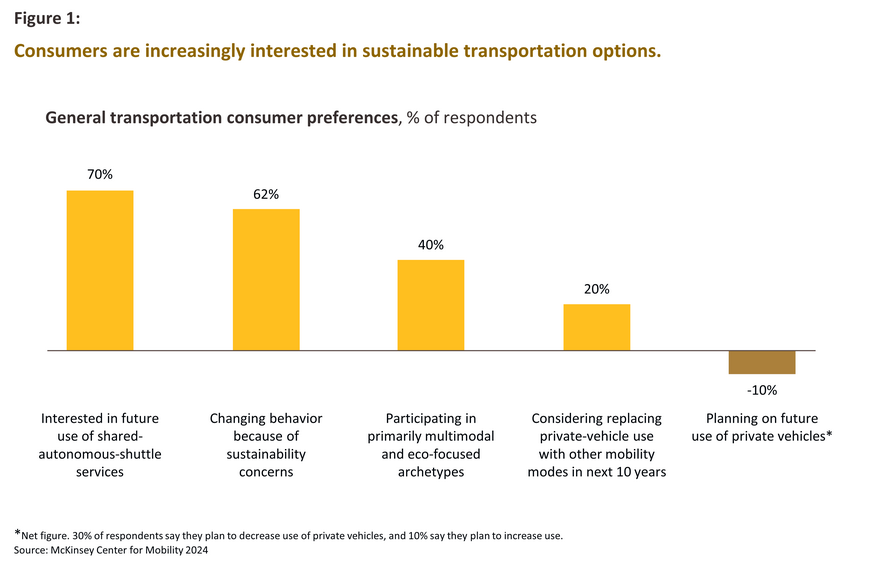
Autonomous Vehicle Innovation: Integrating Advanced Technologies
Types of Autonomous Vehicles and Passenger Transportation
When referring to "autonomous vehicles" or "self-driving vehicles", it generally means vehicles that use technology to replace human driving, either partially or entirely, to move from the starting point to the destination safely, avoiding road hazards and responding appropriately to traffic conditions.
In 2014, the Society of Automotive Engineers (SAE) International established the SAE J3016 standard to serve as a benchmark for the development of autonomous vehicles, categorizing six levels of autonomous driving (Figure 2). The first three levels (Level 0-2) require the driver to maintain control of the steering wheel, though they receive support from systems related to safety, such as blind-spot detection and automatic emergency braking systems. In contrast, the last three levels (Level 3-5) involve vehicles that can operate autonomously using various technologies. At Levels 3 and 4, the vehicle’s automation system functions only under specific conditions and environments. If those conditions change, a human driver must take control. At Level 5, the vehicle can operate entirely independently without any human intervention.
McKinsey forecasts that by 2030, one in eight new passenger cars sold will be autonomous, equipped with Level 3-5 autonomous driving technology. By 2035, more than one-third of new cars in this category will come with this self-driving technology.4/
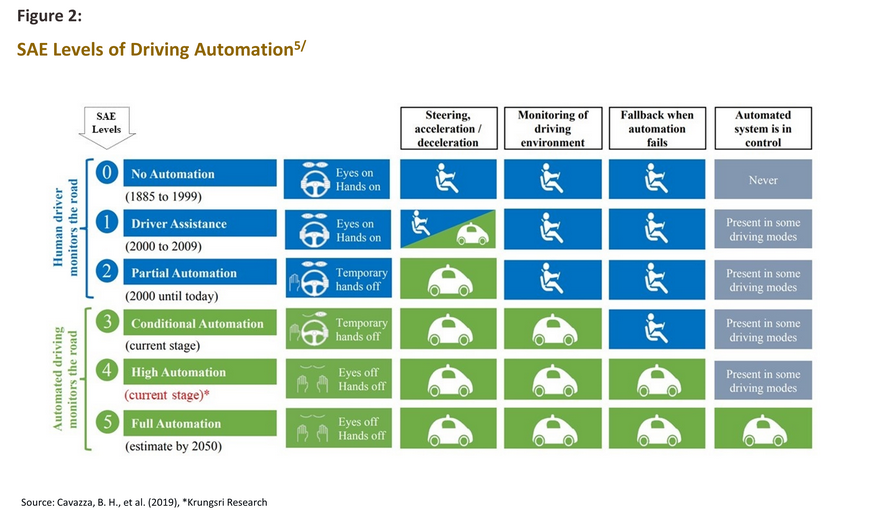
Key Technologies for Autonomous Driving
Autonomous vehicles (AVs) integrate a complex system of technologies, which can be categorized into five key areas:
1) Environmental Perception and Localization: These systems enable the vehicle to accurately understand its surroundings, including:
-
Lidar (Light Detection and Ranging): A laser-based technology that creates 3D maps of the environment, detecting road edges, obstacles, and other vehicles.
-
Radar (Radio Detection and Ranging): Measures distance and speed of nearby objects, providing high accuracy even in poor weather conditions such as rain or fog.
-
Cameras: High-resolution cameras detect traffic signs, road markings, and other environmental cues to enhance situational awareness.
-
GPS and Mapping Technologies: GPS provides location data, while high-definition maps (HD Maps) assist the vehicle in precise localization.
2) Vehicle Control Systems: These are the heart of the AV, responsible for controlling steering, acceleration, braking, and real-time driving adjustments based on environmental data:
-
Steering: Adjusts the steering angle using sensor data (e.g., from Lidar and Radar) to ensure safe driving in complex environments.
-
Acceleration and Braking: Responds to traffic and obstacles, enabling smooth and safe speed changes.
-
Real-Time Action Adjustment: The system collects real-time data from sensors to make timely decisions on speed and direction.
3) Cognitive Decision-Making Processes: These systems allow AVs to make decisions and predict behaviors of other road users to plan safe and efficient routes:
-
Path Planning: Uses traffic data, road regulations, and obstacles to determine the safest route.
-
Prediction Models: Predicts the behavior of other vehicles and pedestrians, allowing the AV to anticipate necessary actions, like when to accelerate or brake to avoid collisions.
4) Performance Optimization Techniques: These techniques analyze data to detect errors and improve efficiency:
-
Error Detection Analytics: Continuously monitors sensor data to identify and correct errors in real-time.
-
Efficiency Improvement Strategies: Uses historical traffic and driving behavior data to optimize routes, reducing travel time and energy consumption.
5) Safety Assurance Mechanisms: Essential components to ensure the safety and reliability of the AV system:
-
Vehicle Connectivity (V2X): Allows the vehicle to communicate with other vehicles (V2V), infrastructure (V2I), and pedestrians to improve safety.
-
Remote Monitoring Systems: Enables remote operators to monitor the vehicle's status in real-time, responding quickly to any issues.
-
Safety Protocols: Emergency safety systems that activate in case of a failure, such as automatic emergency braking or steering control.
In addition to the examples outlined in the five key areas, numerous other technologies are utilized in autonomous vehicles. Each of these technologies plays a crucial role and must work closely together to ensure that autonomous vehicles operate safely and efficiently.
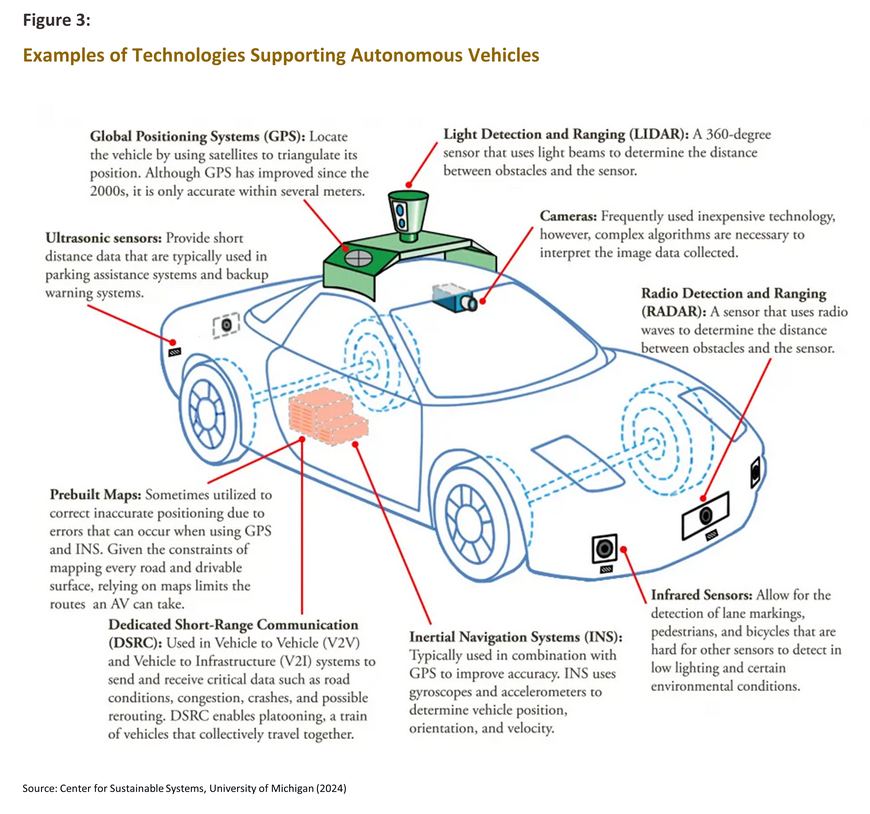
Sustainable Urban Mobility Through Autonomous Vehicles
How Autonomous Vehicles Foster Sustainable Cities
Traffic congestion is a significant challenge faced by many major cities worldwide. In London, in particular, congestion not only causes drivers to lose an average of 139 hours per year due to traffic delays, but it also contributes to the unnecessary emission of 2.2 million tons of carbon dioxide annually.6/ This impacts the environment and undermines the principles of sustainable urban development, particularly those outlined in the concept of Smart Mobility, which emphasizes efficient, convenient, safe, and environmentally friendly transportation systems.
Despite the complexities of addressing traffic congestion, integrating autonomous vehicles into urban public transportation systems and daily commuting offers promising solutions. These vehicles have the potential to enhance mobility efficiency, reduce traffic congestion, and lower air pollution. According to a study by Gawron et al. (2018), autonomous vehicles can reduce energy consumption and greenhouse gas emissions by up to 9% over their lifecycle compared to conventional vehicles.7/ This aligns with sustainable urban development strategies and supports a future where advanced technologies play a central role in everyday life.
Enhancing Autonomous Vehicle Safety
Although autonomous vehicles can reduce energy consumption and improve transportation efficiency, there are still safety concerns. While autonomous vehicles may reduce accidents caused by human errors, such as fatigue, driving under the influence, or distracted driving, recent data from the U.S. National Highway Traffic Safety Administration (NHTSA), as reported by Forbes Advisor (July 30, 2024), indicates that autonomous vehicles are twice as likely to be involved in accidents on the road compared to conventional vehicles. Autonomous vehicles average 9.1 accidents per million miles driven, compared to 4.2 accidents for human-driven vehicles over the same distance.8/ This presents a significant challenge for developers of autonomous vehicle technology.
In addition to advancing existing safety technologies, one promising technology that could help reduce accidents for autonomous vehicles is the use of QR codes. Currently, autonomous vehicles detect signals on the road by analyzing images from cameras, which requires more time and memory to read traffic signs than scanning QR codes. QR codes can be read more quickly and contain information about the meaning and location of traffic signs, reducing the time and memory needed for processing. Furthermore, QR code data can be integrated with Advanced Driver Assistance Systems (ADAS), allowing real-time functionalities, such as notifications or alerts about speed limits, lane restrictions, or potential obstacles on the road, enabling the autonomous vehicle to respond more accurately and quickly,9/ thereby helping to reduce accidents.
At present, there are no fully autonomous vehicles at level 5 that can drive independently. The highest level currently available in commercial autonomous vehicles is level 4, meaning they can operate independently in certain conditions or geofenced environments.10/ This can be seen in autonomous taxi and electric bus services operating in various areas around the world, some still in pilot projects and others fully operational. Full commercial autonomous taxi services are currently available in certain areas of major cities in China, the United States, and the United Arab Emirates.
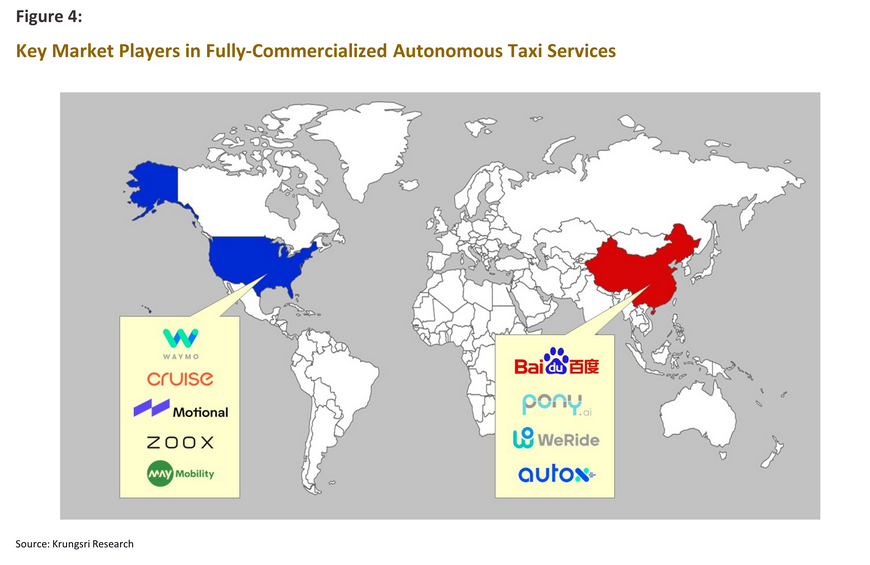
In Thailand, autonomous vehicle (AV) technology is currently at Level 3. This development is part of a pilot project led by the Mobility & Vehicle Technology Research Center (MOVE) at King Mongkut's University of Technology Thonburi (KMUTT), in collaboration with TKC Company. The initiative focuses on developing autonomous electric buses, which were tested for the first time on public roads and offered as a free service around the Phra Ram Park area in the Ayutthaya Historical Park. The service ran from January 31, 2024, to July 2024, with the aim of researching and further advancing autonomous electric vehicle technology in the country.11/
Challenges Facing Autonomous Vehicles
Although the technologies behind autonomous vehicles (AVs) have advanced considerably, they have yet to fully gain consumer trust, particularly concerning safety. According to surveys conducted by the American Automobile Association (AAA) in 2023 and 2024, only 9% of U.S. drivers expressed confidence in AV technology, while approximately 67% remain concerned about safety.12/ In addition to accidents caused by technical errors, AVs are also vulnerable to cyberattacks due to their reliance on internet connectivity, vehicle-to-vehicle (V2V) and vehicle-to-infrastructure (V2I) communications. These connections create potential targets for hackers. GlobalData estimates that Level 5 AV software may contain up to 180,000 coding bugs and 15,000 security vulnerabilities that hackers could exploit.13/ For example, cyberattacks could involve hacking sensors to alter route information or remotely controlling braking systems, posing risks to passengers and surrounding environments.
Regulatory and legal frameworks also present significant challenges. Developing comprehensive policies for AV testing and deployment in urban areas remains a work in progress. Countries like China, the U.S., Canada, Germany, and Singapore have introduced specific regulations to oversee AV testing and usage on public roads. However, in many countries, including Thailand, clear legal frameworks for AV use are still lacking, and existing laws may not fully cover autonomous vehicle operations.
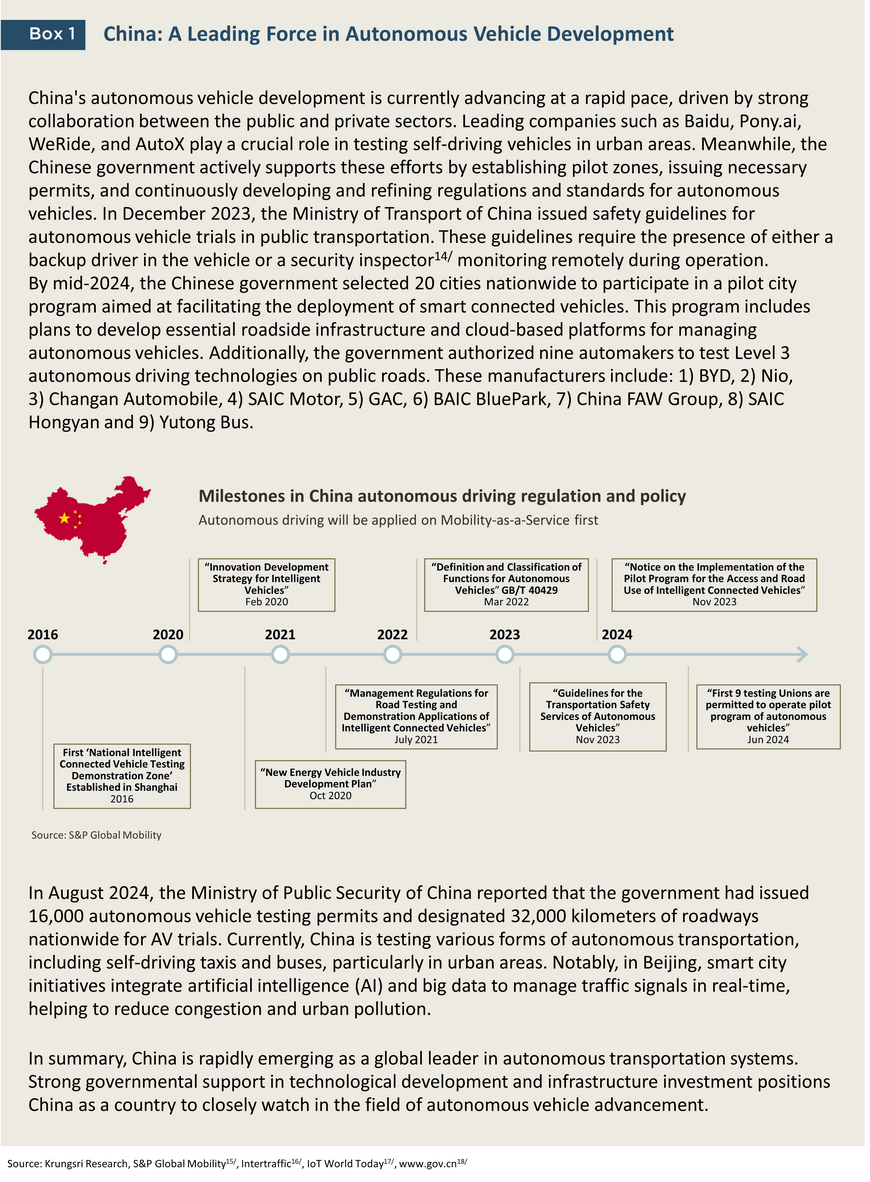
Krungsri Research’s view: Advancing Autonomous Vehicles Amid Challenges
Autonomous vehicles are playing an increasingly important role in developing transportation systems, including freight transport, urban mobility, and mass transit. However, Krungsri Research suggests that integrating autonomous vehicles into sustainable urban development requires comprehensive consideration of various factors, which can be analyzed using the PESTEL framework—covering political, economic, social, technological, environmental, and legal dimensions.
Beyond technological factors mentioned earlier, political factors also play a crucial role. Government policies promoting smart cities and enhancing transportation efficiency are fundamental to supporting the growth of autonomous vehicles. For example, budget allocations for developing infrastructure, such as roads facilitating vehicle-to-infrastructure (V2I) communication or establishing dedicated zones for autonomous vehicles in key areas like business districts or tourist sites, are essential. Notable examples include initiatives in China (Beijing, Shenzhen), the United States (San Francisco, California; Phoenix, Arizona), Japan (Tokyo), and Singapore (One-North district).
In addition to policy considerations, legal support is also essential. Many countries currently have laws regarding the safety of autonomous vehicles, but further regulations and guidelines are needed to ensure proper usage. This includes laws addressing liability in case of accidents involving autonomous vehicles, as well as measures for controlling the use of personal data collected by these vehicles and ensuring its secure storage.
From an environmental perspective, the development of autonomous vehicles should prioritize minimizing environmental impacts. This involves considerations related to infrastructure, policies, regulations, and technologies that reduce energy consumption and pollution, ultimately contributing to the creation of a sustainable transportation system. For instance, developing roads that accommodate autonomous driving, as well as parking spaces and charging stations for autonomous vehicles, are essential components. It is also crucial, however, to assess the environmental impacts of these developments throughout the process.
Economic and social factors must be considered in tandem, as the use of autonomous vehicles can enhance economic efficiency. For instance, the transportation industry can reduce labor costs through the adoption of autonomous vehicles, which also enable faster intercity freight transport due to 24-hour automated driving. Additionally, the development of technology and the maintenance of infrastructure will create new job opportunities. However, the successful integration of autonomous vehicles into transportation systems requires coordination across various sectors of society. This can be explained through economic theory, particularly Game Theory. Specifically, achieving the goal of widespread autonomous vehicle adoption necessitates a situation where each participant must choose actions that align with one another to achieve the best outcomes for all parties involved, known as a “coordination game.”
Examples of coordination games in this context may include: 1) the decision to adopt standardized technologies, where if technology developers and vehicle manufacturers create systems and infrastructure with the same standards, autonomous vehicles will be able to communicate and operate more safely. Using incompatible standards could create system integration issues and safety risks, leading to a lack of public trust in the technology; 2) the government must provide economic incentives and implement regulations in specific areas, such as restricting the use of private vehicles in heritage zones or densely populated traffic areas, to encourage the public to adopt autonomous transportation systems. Governments could also incentivize joint private investment in road networks and vehicle-to-infrastructure (V2I) communication systems to reduce overall costs; or 3) in countries with high numbers of road users but lax traffic enforcement, such as India or even Thailand, autonomous vehicles must be deployed in large numbers in specific areas. If only a few autonomous vehicles are present amidst chaotic traffic conditions that exceed the capabilities of behavioral prediction models, the risk of accidents increases, potentially leading to a lack of public acceptance of autonomous vehicles.
In summary, the integration of autonomous vehicles to enhance transportation systems, making them more efficient and environmentally friendly, is still a goal that faces various challenges and considerations across multiple dimensions. While technological advancements continue, widespread adoption of autonomous vehicles in society will require many more years to build collaboration among stakeholders, develop supporting infrastructure, and establish appropriate regulatory oversight. Nevertheless, research and development across all sectors remain crucial in driving autonomous vehicles towards becoming a viable option for creating a truly sustainable transportation system in the future.
References
จิรธัช เอื้อศิริวัฒนชัย. (2566). บทความเรื่อง “มาตรการทางกฎหมายเกี่ยวกับความรับผิดต่อการควบคุมยานยนต์ขับขี่อัตโนมัติ”. วารสารมนุษยศาสตร์และสังคมศาสตร์ มหาวิทยาลัยราชภัฏบ้านสมเด็จเจ้าพระยา, ปีที่ 17 ฉบับที่ 1 มกราคม-มิถุนายน 2566, สืนค้น 29 ตุลาคม 2567, จาก https://so08.tci-thaijo.org/index.php/jhusocbru/article/view/1545
ณิชกานต์ รัตนเดช. (2562). วิทยานิพนธ์เรื่อง “ปัญหากฎหมายเกี่ยวกับการทดสอบและการใช้งานยานพาหนะขับเคลื่อนอัตโนมัติบนถนนสาธารณะ”. สืบค้น 29 ตุลาคม 2567, จาก https://ethesisarchive.library.tu.ac.th/thesis/2019/TU_2019_5901033794_11418_11808.pdf
Cavazza, B. H., et al. (2019). Management and business of autonomous vehicles: A systematic integrative bibliographic review. International Journal of Automotive Technology and Management, 19(1-2), 31-55. Retrieved November 30, 2024, from https://www.researchgate.net/publication/331689509_Management_and_business_of_autonomous_vehicles_a_systematic_integrative_bibliographic_review
Center for Sustainable Systems, University of Michigan. (2024). Autonomous Vehicles Factsheet. Pub. No. CSS16-18. Retrieved October 3, 2024, from https://css.umich.edu/publications/factsheets/mobility/autonomous-vehicles-factsheet
Gawron, J., Keoleian, G., De Kleine, R., Wallington, T., & Kim, H. C. (2018). Life cycle assessment of connected and automated vehicles: Sensing and computing subsystem and vehicle level effects. Environmental Science & Technology, 52(5), 3249–3256. Retrieved October 21, 2024, from https://css.umich.edu/publications/research-publications/life-cycle-assessment-connected-and-automated-vehicles-sensing
McKinsey Center for Mobility. (March 2024). Spotlight on mobility trends. McKinsey & Company. Retrieved September 27, 2024, from https://www.mckinsey.com/industries/automotive-and-assembly/our-insights/spotlight-on-mobility-trends#
McKinsey Center for Mobility. (January 2023). Autonomous driving’s future: Convenient and connected. McKinsey & Company. Retrieved October 2, 2024, from https://www.mckinsey.com/industries/automotive-and-assembly/our-insights/autonomous-drivings-future-convenient-and-connected
Mercedes-Benz Media Newsroom USA. (2016, September 30). Mercedes-Benz at Mondial de l'Automobile 2016: Mercedes-Benz reinvents itself. Paris/Stuttgart. Retrieved October 16, 2024, from https://media.mbusa.com/releases/release-ad51b833652649a39743dc71b906dd6a-mercedes-benz-at-mondial-de-l-automobile-2016
PwC Lab for Smart Mobility. (2024, April). The Evolution of Shared Autonomous Vehicles (SAV), Part 1: Market potential, user acceptance and early adopter groups. PwC Germany. Retrieved October 2, 2024, from https://www.pwc.de/en/smart-mobility/the-evolution-of-shared-autonomous-vehicles.pdf
SAE Standards. (Current, Revised 2021, April 30). Taxonomy and Definitions for Terms Related to Driving Automation Systems for On-Road Motor Vehicles J3016_202104. Retrieved September 28, 2024, from https://www.sae.org/standards/content/j3016_202104
1/ At the 2016 Mondial de l'Automobile in Paris, Dr. Dieter Zetsche, CEO of Daimler AG and Head of Mercedes-Benz Cars, introduced for the first time the four key trends transforming the automotive industry, collectively referred to as “CASE.” These trends include Connectivity, Autonomous Driving, Shared Mobility, and Electric Drive Systems. This marked the beginning of widespread discussions about “CASE,” which has since been recognized as a pivotal framework influencing the direction and future of the global automotive industry.
2/ McKinsey Center for Mobility. (March 2024). Spotlight on mobility trends. McKinsey & Company. Retrieved September 27, 2024, from https://www.mckinsey.com/industries/automotive-and-assembly/our-insights/spotlight-on-mobility-trends#/
3/ Out of the total sample (n = 27,869) from Brazil, China, France, Italy, Japan, Norway, South Africa, and US.
4/ McKinsey Center for Mobility. (January 2023). Autonomous driving’s future: Convenient and connected. McKinsey & Company. Retrieved October 2, 2024, from https://www.mckinsey.com/industries/automotive-and-assembly/our-insights/autonomous-drivings-future-convenient-and-connected
5/ SAE Standards (Current, Revised 2021, April 30). Taxonomy and Definitions for Terms Related to Driving Automation Systems for On-Road Motor Vehicles J3016_202104. Retrieved September 28, 2024, from https://www.sae.org/standards/content/j3016_202104/
6/ IMO-HSG and PwC Analysis in “The Evolution of Shared Autonomous Vehicles (SAV)” (April 2024) by the PwC Lab for Smart Mobility
7/ Although the computer systems and various sensors in autonomous vehicles increase energy consumption and greenhouse gas (GHG) emissions, improved driving efficiency—such as smoother traffic flow and reduced fuel use—can offset these impacts, ultimately leading to a reduction in overall energy consumption and GHG emissions (Gawron et al., 2018).
8/ https://www.forbes.com/advisor/legal/auto-accident/perception-of-self-driving-cars
9/ https://ieeexplore.ieee.org/document/10150833
10/ A geofenced environment refers to a setting where geographical boundaries are defined on a digital map using technologies such as GPS, RFID, Wi-Fi, or cellular signals to create virtual perimeters that control or restrict vehicle movement within that area. In the context of autonomous vehicles, geofencing designates specific areas where self-driving cars can operate safely. These areas may include urban zones, industrial zones, or other designated spaces with appropriate infrastructure and regulations in place.
11/ https://forbesthailand.com/news/it/first-automous-ev-bus-in-thailand
12/ https://newsroom.aaa.com/2024/03/aaa-fear-of-self-driving-cars-persists-as-industry-faces-an-uncertain-future
13/ https://www.globaldata.com/media/automotive/180000-bugs-every-fully-autonomous-vehicle-like-open-door-cyber-criminals-says-globaldata
14/ Each Security Inspector can monitor up to three vehicles simultaneously.
15/ https://www.spglobal.com/mobility/en/research-analysis/China-autonomous-vehicles-development.html
16/ https://www.intertraffic.com/news/autonomous-driving/china-autonomous-vehicle-innovations
17/ https://www.iotworldtoday.com/transportation-logistics/china-approves-advanced-self-driving-trials-for-nine-automakers
18/ https://english.www.gov.cn/news/202312/06/content_WS656fe5b4c6d0868f4e8e1ee4.html